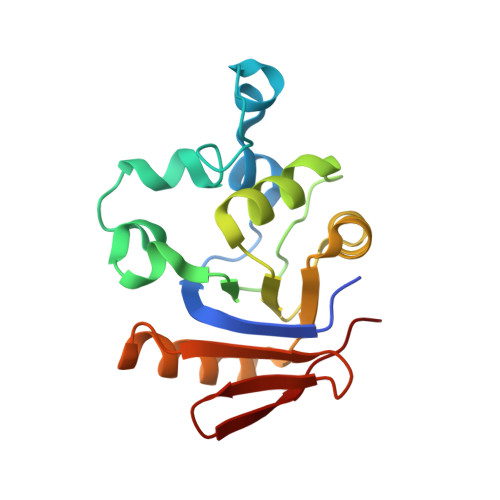Structural studies on the enzyme complex isopropylmalate isomerase (LeuCD) from Mycobacterium tuberculosis
Manikandan, K., Geerlof, A., Zozulya, A.V., Svergun, D.I., Weiss, M.S.(2011) Proteins 79: 35-49
- PubMed: 20938981
- DOI: https://doi.org/10.1002/prot.22856
- Primary Citation of Related Structures:
3H5E, 3H5H, 3H5J - PubMed Abstract:
The absence of the leucine biosynthesis pathway in humans makes the enzymes of this pathway in pathogenic bacteria such as Mycobacterium tuberculosis potential candidates for developing novel antibacterial drugs. One of these enzymes is isopropylmalate isomerase (IPMI). IPMI exists as a complex of two subunits: the large (LeuC) and the small (LeuD) subunit. The functional LeuCD complex catalyzes the stereospecific conversion reaction of α-isopropylmalate to β-isopropylmalate. Three C-terminally truncated variants of LeuD have been analyzed by X-ray crystallography to resolutions of 2.0 Å (LeuD_1-156), 1.2 Å (LeuD_1-168), and 2.5 Å (LeuD_1-186), respectively. The two most flexible parts of the structure are the regions of residues 30-37, the substrate discriminating loop, and of residues 70-74, the substrate binding loop. The three determined structures were also compared with the structures of other bacterial LeuDs. This comparison suggests the presence of two LeuD subfamilies. A model for the structure of the inactive enzyme complex has been obtained from solution X-ray scattering experiments. The crystal structure of LeuD was shown to be compatible with the solution X-ray scattering data from the small subunit. In contrast, the solution scattering results suggest that the large subunit LeuC and the LeuCD complex have overall shapes, which are radically different from the ones observed in the crystals of the functional homolog mitochondrial aconitase.
Organizational Affiliation:
EMBL Hamburg Outstation, c/o DESY, Notkestr. 85, D-22603 Hamburg, Germany.














